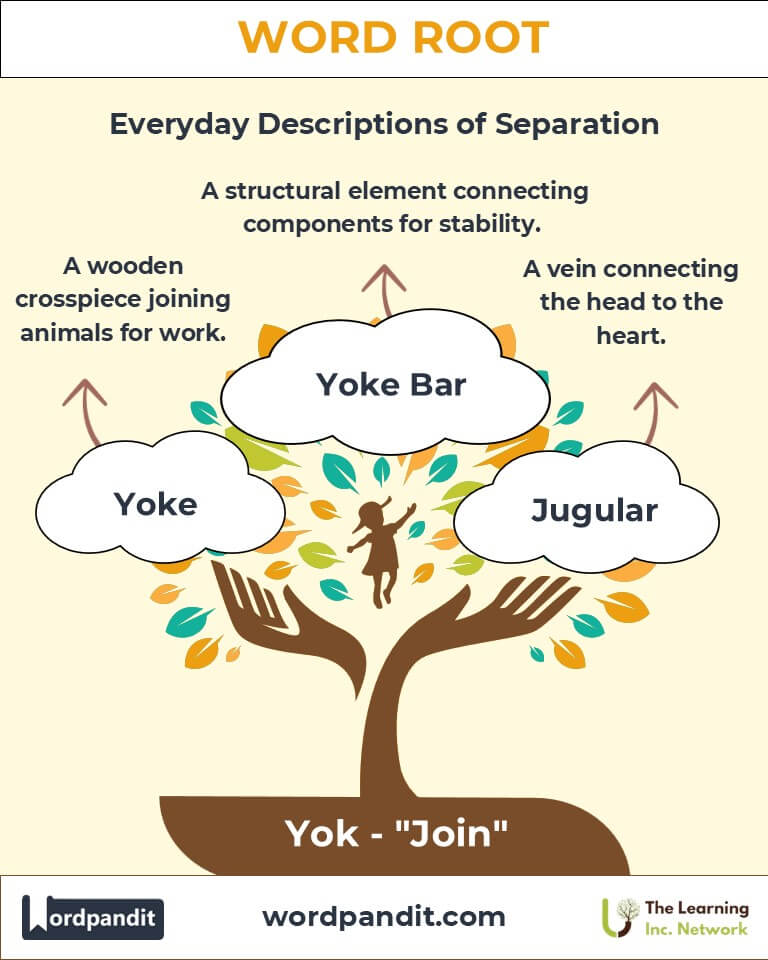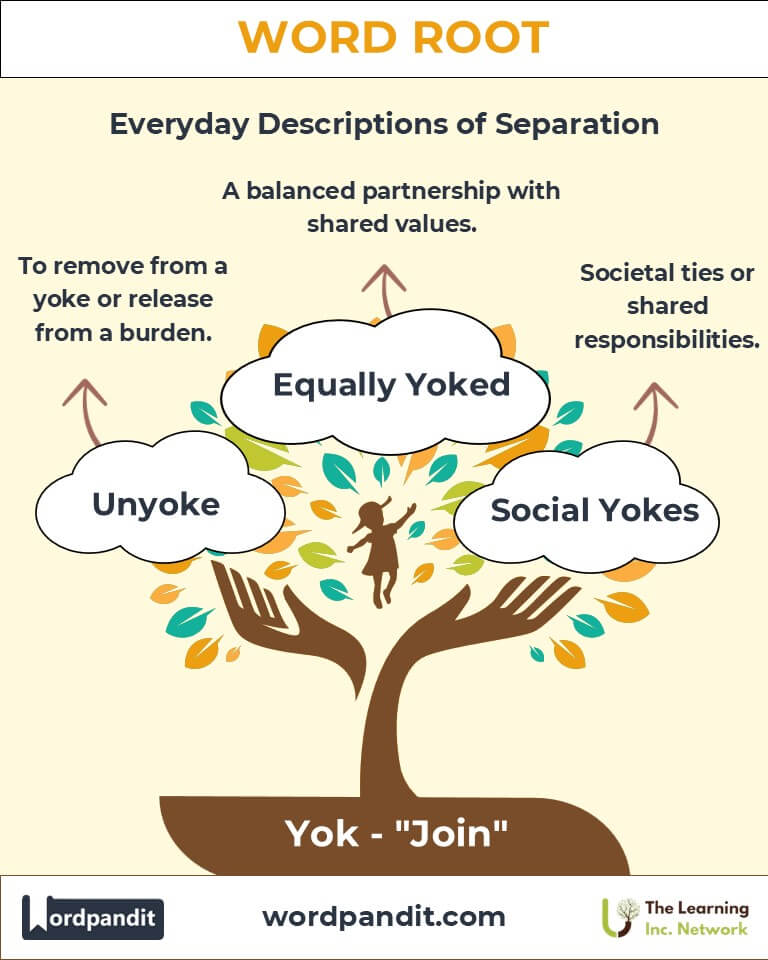Yok: The Root of Connection and Unity
Discover the essence of the root "yok," derived from the concept of "join." From its literal use in tools and mechanisms to its metaphorical significance in relationships and teamwork, this root forms the foundation of terms symbolizing collaboration and interconnectedness.

Table of Contents
- Introduction: The Essence of "Yok"
- Etymology and Historical Journey
- Mnemonic: Unlocking the Power of "Yok"
- Common "Yok"-Related Terms
- "Yok" Through Time
- "Yok" in Specialized Fields
- Illustrative Story: "Yok" in Action
- Cultural Significance of "Yok"
- The "Yok" Family Tree
- FAQs About the "Yok" Word Root
- Test Your Knowledge: "Yok" Word Root Quiz
- Conclusion: The Living Legacy of "Yok"
1. Introduction: The Essence of "Yok"
Imagine the strength of a pair of oxen working in harmony, their movements synchronized by a sturdy yoke. The root "yok", meaning "join," captures this spirit of unity and partnership. Pronounced as "yohk," it originates from Old English and shares ties with languages emphasizing connection and functionality. From agricultural tools to human relationships, "yok" underscores the importance of alignment and cooperation.

2. Etymology and Historical Journey
The root "yok" traces its origins to Old English geoc and Proto-Germanic jukam, referring to a device that binds animals for plowing or hauling. This word evolved into a metaphor for teamwork and partnership, appearing in diverse contexts, including literature and law. As societies transitioned from agrarian to industrial economies, "yok" retained its symbolic meaning while gaining broader applications.
3. Mnemonic: Unlocking the Power of "Yok"
Visualize two individuals, arms linked, pulling together to move a heavy load. This image encapsulates the essence of "yok" as a force of connection and shared effort.
Mnemonic Device: “Yok unites to conquer, two are better than one.”
4. Common "Yok"-Related Terms
- Yoke (yohk)
- Definition: A wooden crosspiece that joins a pair of animals for work.
- Example: "The farmer adjusted the yoke to ensure the oxen were comfortable."
- Unyoke (uhn-yohk)
- Definition: To remove from a yoke or release from a burden.
- Example: "At sunset, the farmer would unyoke the oxen, allowing them to rest."
- Yoked (yohkt)
- Definition: Bound or connected, often in a metaphorical sense.
- Example: "The couple was yoked together by their shared dreams."
- Overburdened (oh-ver-bur-duhnd)
- Definition: Figuratively derived from "yoke," indicating being weighed down.
- Example: "She felt overburdened by the yoke of expectations."
5. "Yok" Through Time
- Past: In medieval times, "yoke" symbolized servitude or obligation, often linked to feudal systems where peasants "bore the yoke" of their lords.
- Present: Modern usage embraces metaphorical meanings, such as partnerships in business or relationships where individuals are "equally yoked."
6. "Yok" in Specialized Fields
- Agriculture:
- Yoke: A tool ensuring synchronized movement of animals in farming.
- Impact: Revolutionized traditional plowing techniques.
- Engineering:
- Yoke Bar: A structural element connecting components for stability.
- Relevance: Used in machinery and construction.
- Sociology:
- Social Yokes: Describes societal ties or shared responsibilities.
- Example: Bonds in community service initiatives.
7. Illustrative Story: "Yok" in Action
On a small farm, a young girl named Clara watched her father yoke two oxen to till the soil. As they worked in unison, she marveled at their coordination. Years later, inspired by this memory, Clara led a team-building exercise at her workplace, using the concept of a yoke to emphasize the importance of collaboration. Her efforts fostered a stronger, more unified team.
8. Cultural Significance of "Yok"
The yoke has been a symbol of unity and shared purpose across cultures. In biblical contexts, it represents balance and harmony in relationships. Eastern philosophies interpret the yoke as a tool for spiritual alignment, reflecting the interconnectedness of all beings.

9. The "Yok" Family Tree
- Jug (Latin)
- Junction: A point where two or more things meet.
- Jugular: A vein connecting the head to the heart.
- Con (Latin)
- Connect: To join or link.
- Consensus: General agreement.

10. FAQs About " Yok "
Q: What does the root "yok" mean?
A: The root "yok" originates from Old English "geoc" and Latin "jugum," meaning "to join" or "to link." It is commonly used to describe connections, partnerships, or burdens.
Q: How does "yoke" relate to "yok"?
A: "Yoke" refers to a wooden frame used to join animals, such as oxen, for plowing or pulling. It symbolizes partnership and connection, derived from the root "yok."
Q: What does "unyoke" mean?
A: "Unyoke" means to remove a yoke or to free someone from a burden or obligation. It uses the prefix "un-" to indicate separation or release.
Q: What is the figurative meaning of "yoke"?
A: Figuratively, "yoke" represents a burden or oppressive constraint, such as the yoke of tyranny or servitude. It emphasizes an enduring connection, often involuntary.
Q: How is "conjugal" connected to "yok"?
A: "Conjugal" refers to the bonds of marriage, derived from the Latin "jugum," meaning "yoke." It signifies the joining or union of two people in matrimony.
11. Test Your Knowledge: " Yok " Mastery Quiz
1. What does the root "yok" signify?
2. What does "yoke" symbolize figuratively?
3. What does "unyoke" mean?
4. What does "conjugal" pertain to?
5. What is the primary use of a "yoke"?
12. Conclusion: The Living Legacy of "Yok"
The root "yok" continues to inspire concepts of unity and collaboration, bridging historical and modern contexts. From ancient farms to modern workplaces, its symbolism underscores the strength found in partnership and mutual support. Let "yok" remind us of the power of joining forces to achieve greater harmony and success.












